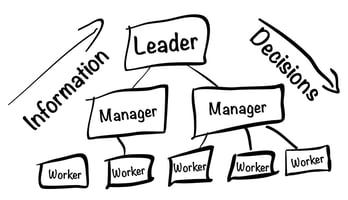Have you ever seen a bright, capable person become frustrated when the organization doesn’t make...
Negotiating change with your internal partners
As your organization’s digital transformation begins to take hold, you’ll find that many of your internal partners cling to the old ways of doing things. There’s nothing nefarious about this: change is difficult and can create uncertainty in people who previously felt confident and high performing in their roles. Reorienting everyone’s orientation to be focused on caring for your customers first is going to take time. Even teams who want to change feel pressure to prioritize other organization values, such as cost savings, governance, or compliance to internal or external standards. Many compliance teams may not now what can be changed having been conditioned to treat all rules as equal.
Here are a few steps that can help make your journey with your partners amicable and straightforward.
Step 1: Remember it’s a negotiation
Your internal partners, like you, are busy managing a number of competing priorities. Your success as a leader will come down to your ability to negotiate change with them. All negotiation occurs in the mind of your counterpart. Therefore, effective leaders take the time to understand their partners’ challenges and look for opportunities for both groups to be successful.
Step 2: Agree on who their customers are
Some groups in an organization are responsible not only for providing a service to teams, but are accountable for enforcing policies that keep the business in compliance with government regulations or external customer commitments. For those organizations (data management often finds itself in this position), realizing that they actually serve two types of customers (at least) is critical.
A compliance oriented team may feel their primary customer is legal, or risk management, or finance because they most influence the team’s rules to be followed. They may see the software engineering team as the biggest risk to their own ability to succeed. “If this team doesn’t follow the rules, I could get in trouble” is a belief, explicit or not, in the way they approach work. They may also shift the burden of demonstrating compliance to their partner, protecting themselves from risk. If you show up and act like the most important customer they have, you won’t be able to influence nearly as well than if you acknowledge they have other pressures in their world.
As a partner, it’s important to understand the needs of those customers because it will shape your relationship with the internal partner. If the partner uses a “one size fits all” approach to engaging their primary customers, it may be because it simplifies their compliance needs. Can that approach become more nuanced? How would they classify their customers, and how would that affect their need for governance?
Your goal is to protect what is most important for both of you so that you can both serve the broad organization. Pushing for mutual trust and team empowerment with sensible and appropriate controls are the values that guide your mutual path toward this goal. Your team is an internal customer, not “just” a risk to be managed.
Step 3: Describe what success looks like
Partners should agree that their primary success metric is their customers’ (yours) satisfaction, and agree on how that will be measured and utilized. Some teams even formalize this measurement with surveys. The rest will follow naturally as you are now giving them a way to demonstrate value to the business that is richer than just compliance.
One team I worked with had an ask of an internal partner to create a self-service process, with upfront guidance and support to help the team use their services effectively. Their pain was an elaborate sequence of process steps that required experience to master and ultimately created many false starts and barriers to getting tasks done. This kind of mastery of the system often becomes the domain of project managers who serve as a middle man for teams. It goes without saying that direct communications between a customer and a service provider is always more efficient.
We worked with the team and agreed that the upfront support can come in the form of FAQs, Slack channels, or a dedicated enablement team that works with the product team to solution an engagement that works well and then implements. These will all replace lengthy request forms that poorly attempted to gather all the needs without human interaction. The goal should not be to come in with a specific solution but to help your partners brainstorm ideas and test what is feasible.
Step 4: Agree on next steps
Whatever it is that you recognizes is your most pressing need, you’ll need to negotiate a change with the partner. They’ve got their own competing priorities, and like it or not, yours is just one more. As you’re discussing options, be sure to ask lots of “how” questions to insure that hidden problems are uncovered: “how will the rest of the team feel about this?” “How will you address these issues with compliance?” “How will we know when it’s working?” The more concrete their vision becomes about how they can help, the more committed they will feel and the more likely follow through will occur.
Look for areas where your team can support the change. Perhaps before getting a true self-service API, in the meantime you could perform requests via email to a human being that does the work. Or maybe you can loan some engineering talent to the partner to help them develop and API or website.
Step 5: Frequently check in to see how things are coming
As your relationship with your internal partner progresses, check in to see how they’re doing. If they’re stumbling into roadblocks, be prepared to renegotiate your agreement, and be ready to share the impact that will have on your team. Be ready to engage leaders not only when you need their help, but to acknowledge the effort and any minor successes.
Summary
Getting a partner to transform the way they work with you can be daunting. Use the suggestions above to achieve lasting results.
1. Remember it’s a negotiation – be prepared to compromise
2. Agree on who their customers are – you might not be the only one they’re accountable to
3. Describe what success looks like – what would you like the boundaries between the organizations to look like?
4. Agree on next steps – assuming they can’t give you everything you want, what should come next?
5. Frequently check in to see how things are coming – stuff happens; better to know where your stuff is in the queue



